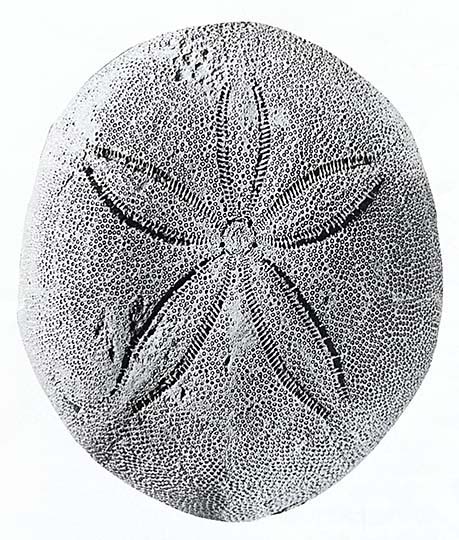Echinoids range from the Paleozoic (starting in the Ordovician Period) to modern day. As adults, they crawl about on the ocean floor. Like all the other invertebrates, echinoids underwent significant changes in their modes of life during Mesozoic time because of increasing predation by predators.
Figure 1: Life zones of regular echinoids versus geologic time.
Order Oligopygoida
Family Oligopygidae
Range: Lower Eocene, Baja California Sur, Mexico. THIS IS A FOSSIL SPECIES. It is both the earliest and the westernmost oligopygoid, and the first occurrence of Haimea in North America.
This is a fossil species. Baja California Sur, Mexico.
Habitat: Shallow-marine.
Source of Information: Squires and Demetrion, 1994.
Dimensions of Figured Specimen: Length 18 mm, width 15.7 mm.
Figure 1a: top view.
Figure 1b: side view.
Calilampus californiensis Squires, 1995
(two views: top and left side)
Order Cassiduloida
Family Cassidulidae
Range: Lower Eocene, Baja California Sur, Mexico. THIS IS A FOSSIL SPECIES.
Habitat: Shallow-marine.
Source of Information: Squires and Demetrion. 1995.
Dimensions of Figured Specimen: Length 3.5 cm, width 2.9 cm.
Order Spatangoida [The heart-shaped echinoids].
Family Loveniidae
Range: Santa Cruz Island, southern California to Panama, Coco Islands, and the Galapagos; rare in Columbia.
Habitat: Infaunal (about 15 cm depth) in sandy sediment, in the low-intertidal zone to a depth of 200 m.
Shell: Surface is covered by long, brown hair-like spines; the shell resembles a small coconut.
Source of Information: Marine Biodiversity Records “https:/mbrbiomedicalcentral.com
Dimensions of Figured Specimen: Length 5.4 cm, width 3.6 cm.
Micraster cor-anguinum (Leske), a plaster cast.
(four successive views: top, left side, bottom, posterior)
Order Spatanogoida
Family Micrasteridae
Range: THIS IS A FOSSIL SPECIES. Upper Chalk beds, Upper Cretaceous (Senonian), from Pinden, near Dartford, Kent, England.
Fossil Locality: This genus lived from Late Cretaceous (Cenomanian) to early Eocene. It was moderately widespread, with species in Europe, North America (mainly the Gulf Coast states), Egypt, and Antarctica (rare).
Source of Information: Wikipedia (2023).
Dimensions of Figured Specimen: length 6 cm, width 5.3 cm.
Meoma ventricosa? (Lamarck, 1816)
(three views: top, bottom, and left side)
Order Spatnagoida
Family Brissidae
Common Names: Cake urchin and “red heart” urchin.
Range: Florida, the Bahamas, Bermuda, Jamaica, Virgin Islands, and West Indies, Caribbean, southern Mexico, northern Venezuela.
Habitat: Shallow waters. They burrow into sand at the rate of about 3 to 6 cm an hour during the day, and twice as fast during the night.
Shell: Spines blackish-red in color.
Source of Information: Wikipedia (2023).
Dimensions of Figured Specimen: Length 135 cm, width 112.5 cm, thickness 67 cm.
Agassizia scrobiculata Valenciennes, 1846
(four views: left to right--for both rows--top,
bottom, left side, and posterior)
Order Spantangoida
Family Prenasteridae
Common Name:
Range: Only two known species. Upper Gulf of California, Baja California, Mexico to Peru and the Galapagos Islands.
Habitat: Largely subtidal, at depths 0 to 76m, on sandy, muddy, or rocky bottoms.
Shell: Small, normal size 20 to 35 mm length.
Source of Information: Brusca (1980).
Dimensions of Figured Specimen: Length 35 mm, width 30 mm, thickness 26 mm.
References Cited:
Brusca, R. C. 1980. Common intertidal invertebrates of the Gulf of California. Second edition. The University of Arizona Press, Tucson, Arizona, 513 pp.
Squires, R.L. and R.A. Demetrion. 1994. A new species of the oligolpygoid echinoid Haimea from the lower Eocene of Baja California Sur, Mexico. Journal of Paleontology 68(4):pp. 846–851, figs. 1–3.
Squires, R.L. and R.A. Demetrion. 1995. A new genus of cassiduloid echinoid from the lower Eocene of the Pacific coast of western North America and a new report of Cassidulus ellipticus Kew, 1920, from the lower Eocene of Baja California Sur, Mexico. Journal of Paleontology 69(3):509–515.
en. Wikipedia.org


















No comments:
Post a Comment